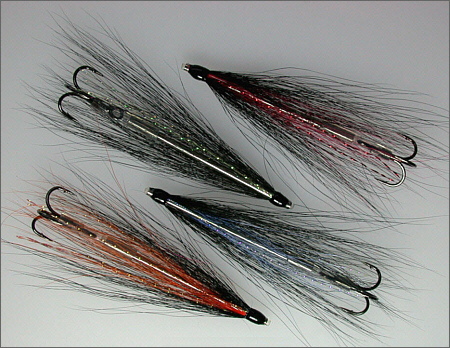Needle Tube Flies

Read more
about
NEEDLE TUBE FLIES
Over the
years, there have been many innovations in the world of fly
tying, particularly in the design of flies and lures for
salmon fishing. We might include in this flies aimed at both
Atlantic and Pacific salmon and at Steelhead in North
America, together with flies for salmon and sea trout
fishing in Europe, particularly in the U.K., in the
Scandinavian countries, and in Russia. Recent years have
seen the development of many and varied innovative designs.
Whether his chosen quarry is the salmon, steelhead or sea
trout, today's fisherman has a great many weapons in his
armoury, ranging from simple single, double or treble hooks,
short or long in the shank, barbed or barbless; snakes and
needle flies; coneheads, bottle tubes and turbo discs. The
tube fly has long been a favourite of many fly tyers,
available in a variety of materials, such as plastic,
aluminium, copper and brass, allowing flytyers to make tube
flies in a useful range of lengths and weights to suit most
river conditions. Another great advantage of the tube fly is
its durability, as the hook, whether single, double or
treble, can be easily replaced when damaged.
I am a great
fan of very slimline fly bodies, particularly for sea trout
fishing at night but also for salmon. For many years now, I
have used
needle flies, the
slimmest of all flies. More recently, I collaborated with
Dave Wallbridge in developing
micro
tube flies,
undoubtedly the thinnest metal tube fly ever devised, with
an outside diameter of 1.1mm (19 gauge stainless steel
tubing) or less than 1mm (20 gauge stainless steel tubing).
Because it was impossible to line such slim tubes with the
traditional plastic liner and still allow room for the
leader to be passed through the tube, our early micro tubes
made use of heat shrink tubing to shield the nylon leader
from the sharp tube ends and very effective they were, too,
if a little unconventional.
Online forum
discussion of the possibilities presented by our stainless
steel micro tubes prompted renewed efforts to develop slim
stainless steel tubes of the more conventional kind,
employing a traditional plastic liner, with a view to making
them available to fly tyers worldwide. Reverting to the
traditional lining method would not, of course, produce such
slim tubes as our original micro tubes but the resulting
needle tubes come pretty close, with a minimum outside
diameter of 1.5 mm., slimmer than any other commercially
produced lined fly tying tubes. Being made from polished
stainless steel, the kind used in the making of hypodermic
needles, they sink more readily than aluminium tube flies
but fish a little higher, and more attractively, than the
heavier copper and brass tubes. Needle Tube flies would have
a comparable sink rate and similar slim profile to flies
dressed previously on Waddington shanks, but with the
important benefit that the hook is easily changed on the
needle tube fly. Needle tubes are also much easier to dress
than Waddington or snake lures.
See also
How to make a knot guard (or swing
tube) for a Free Swinging Tube
Fly Hook
Sea Trout Articles |
|